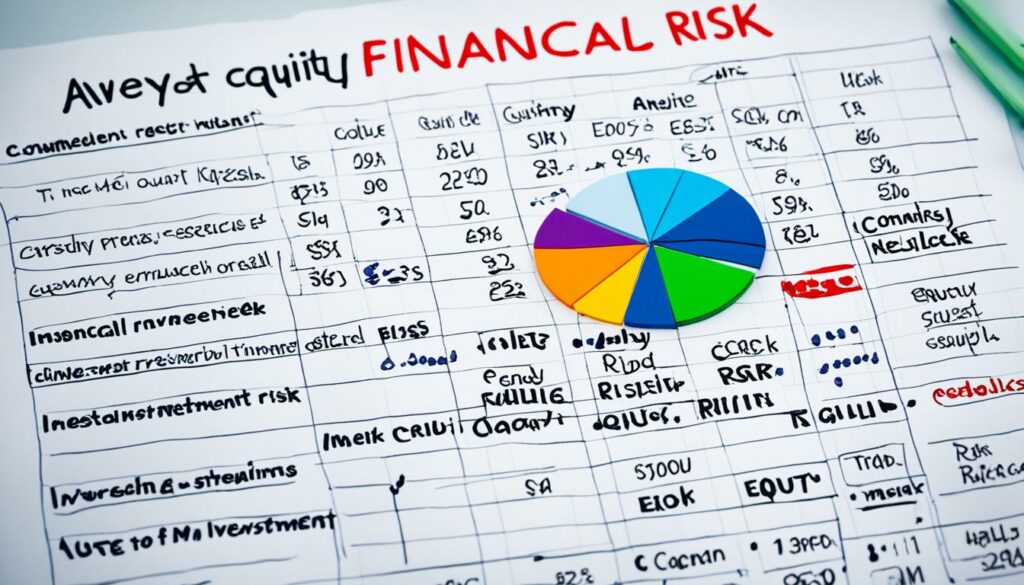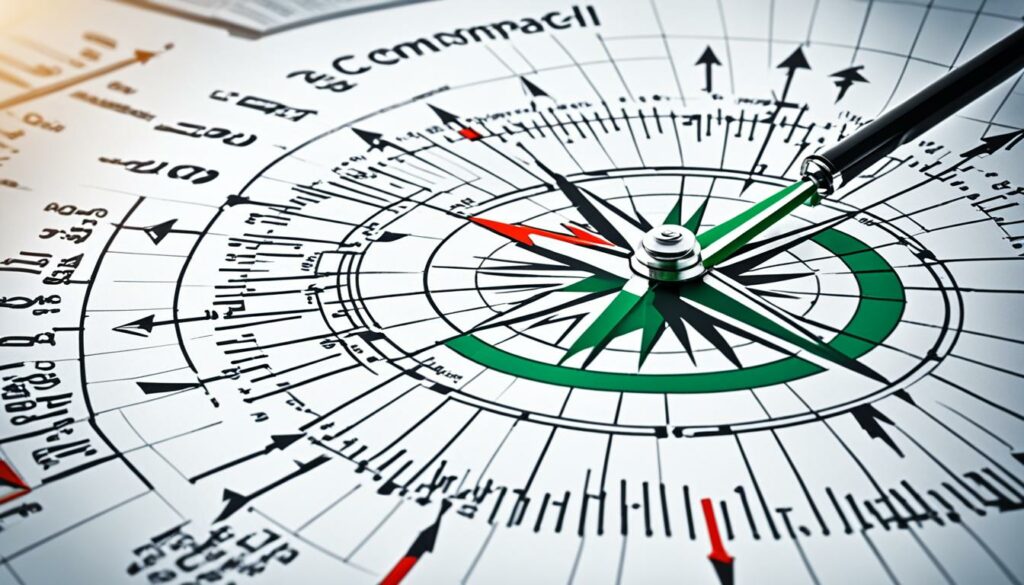Menu

Did you know that in 2019, over 30 jury awards exceeded $1 billion in medical liability verdicts? This fact shows the challenge in managing market risk today. Market risk is the threat of your investment dropping due to market changes. It’s vital for every investor to understand.
Managing risk involves being good at telling stocks from shares. A strong portfolio needs careful research and knowledge of the markets. Investors should also be ready for ups and downs, more than just choosing investments without a plan.
To beat market risk, knowing and reacting to different threats is key. Always using proven strategies and sound theory in your choices will lower your risks. This way, you aim for success over the long term.
Market risk is key for all investors. This includes looking at how markets move and predicting changes in the economy. The risk is the chance of losing money because of general market trends.
Market risk, or systematic risk, means you might lose money because of market-wide factors. It’s part of any investment and can’t be avoided by spreading your money. It involves things like changes in interest rates, shifts in currency values, and general market movements.
Market risk comes from different sources. These can be interest rate changes, currency value shifts, political events, and downturns in the economy. They mix together to shape the overall market environment. For instance, a change in interest rates can affect the value of bonds and stocks.
Changes in currency values can hurt the profits of companies that operate internationally.
Understanding market risk is vital for investors to expect and plan for potential losses. Knowing how to measure market activity and economic risks helps in making tougher investment choices. Techniques like hedging, spreading investments, and stress testing are ways to lower market risks. This knowledge is crucial for creating investment plans that match your financial aims and tolerance for risk.
Understanding market risk deeply helps investors in making wise choices and making their portfolios more resistant to big market changes.
Investors need to understand different market risks for strong portfolios. They face risks like changes in interest rates, credit risks, and liquidity risks. This requires a full look at financial risks.
Interest rate risk comes from changes in interest rates, often due to policy changes. These changes affect demand and supply for bonds, changing prices. Investors need to watch interest rates closely to protect their bond and interest-based investments.
Credit risk is the chance someone won’t pay back what they owe. It’s crucial for investment planning. Checking how reliable bonds and companies are helps lower the risk.
When buying or selling is hard without changing prices much, it’s liquidity risk. This is tough in slow markets. Checking how easy it is to sell investments helps avoid selling at bad prices.

Handling these risks well is crucial for a strong investment plan. Knowing about interest rates, credit, and liquidity risks helps investors do better in tricky financial times.
Market risk assessment involves many approaches. This ensures a deep look at possible financial dangers. By mixing numbers with expert insights, the understanding of risk gets better.
In assessing market risk, I mix numbers with expert views. Quantitative ways use data and maths to show risk. On the other hand, qualitative talks about the expert’s opinion on market conditions. This mix helps get a full picture of risks.
The risk matrix is key in market risk check-ups. It gives scores to risks based on how likely they are and how big their impact could be. This helps see the biggest threats and focus on handling them first. Matrices organise the process of looking at both numbers and opinions on risks.
High-end stats models are critical for deep risk checks. They help us understand how much a portfolio might lose in a set time and market setting. These models, like Value at Risk (VaR), use different approaches to give detailed looks at possible market movements.
| Model | Description | Advantages | Limitations |
|---|---|---|---|
| Parametric (Variance-Covariance) | Assumes normally distributed gains and losses | Simple, effective for normally distributed data | May underestimate extreme events |
| Historical Simulation | Uses past market data to estimate risks | Reflects actual historical performance | Limited by historical events, may not predict future |
| Monte Carlo Simulation | Generates random outcomes from specified distributions | Provides wide range of scenarios | Complex and computationally intensive |
Understanding market risk as a new investor can seem tough. However, using simple methods makes it easier to see the risks. This leads to better choices.
It’s key for newbies to learn the basics of market risk. Start with things like VaR to figure out potential losses. Use methods like historical simulation to see outcomes under different scenarios.
Beginners should also look at how each asset reacts to risk changes. This helps in understanding the overall picture.
Tools for new investors are there to cut through complexity. They include VaR calculators, diverse portfolio builders, and risk apps. These tech tools can help in making smart investment choices.
| Tool | Functionality | Suitability for Beginners |
|---|---|---|
| VaR Calculators | Estimate potential portfolio losses | High |
| Portfolio Builders | Automatically balance asset classes | Moderate |
| Mobile Risk Apps | Provide real-time risk updates | High |

Looking at successful cases can teach a lot about avoiding risks. For example, diversifying investments and using hedging tools helped some when the market was uncertain. These approaches spread the risk and protected against big losses.
By using simple risk methods, the right tools, and studying successful cases, new investors can get a grip on risk. This helps in making strong investment portfolios.
Advanced market risk management methods look at potential financial impacts under different market conditions. These let portfolio managers spot weaknesses and get ready for market changes. Now, let’s dive into some key advanced techniques.
VaR models help teams estimate the minimum expected loss in a portfolio, considering certain market scenarios. You can estimate VaR through various methods such as parametric, historical, and Monte Carlo simulations. The good thing about VaR models is they’re clear, work for different assets, and are accepted by rules. Yet, they might be too simple, open to bias, and could miss rare big events. There are also advanced forms of VaR, like CVaR and IVaR, which give more details.
Scenario analysis shows how a portfolio might react to specific market scenarios, both past and made-up ones. It helps investors understand how different factors could change in each scenario. This helps in getting ready for events that might happen, though not regularly, in the market.
Stress testing checks how a portfolio would do in very challenging market situations. It’s key for seeing the effect of big unexpected events. By doing this, risk managers make sure the portfolio can stand against big financial shocks. Complementary to stress testing is reverse stress testing, which checks the other way around, finding possible weak points in strategies.
Using these methods together – VaR models, scenario analysis, and stress testing – helps in understanding financial situations better. They’re critical for managing complex market risks, shielding investments from the many surprises the market can bring.
Diversification is key in managing risk well. It involves spreading investments across different areas and types. This helps lessen the impact of market drops.

Asset allocation is vital for diversification. It means spreading money over various assets, industries, and more. Records from over 200 years show that doing this leads to more stable returns.
In the 2008 crisis, those with diverse investments fared better. This was compared to those focused on just one asset type.
It’s also key to diversify in sectors and areas. Sectors like utilities and healthcare often stay strong, even in tough times. And spreading investments across different locations can reduce risks like local economic issues.
Good diversification should cover at least eight types of investments. This includes stocks, bonds, and alternative choices like real estate.
Diversification’s benefits are clear, but it has limits too. It doesn’t ensure profit or shield from losses in a market fall. It needs regular handling and might not work well in big market crashes.
Pairing diversification with other methods, like stop-loss orders, improves it. This helps sell assets if their price drops too low, reducing potential losses.
Getting advice from a financial advisor can make diversification more effective. They can offer strategies that fit the changing market well.
Understanding the strengths and weaknesses of diversification is vital. With a smart mix of diversification and other strategies, investors can manage risks wisely. This helps them navigate the ups and downs of the financial world.
Keeping an eye on your portfolio and making regular changes are key. This helps to keep your investment mix steady. It’s important to manage risks and update your plans with market shifts. Doing this can greatly help your portfolio do well over time.
It’s crucial to regularly check the portfolio for risks. This means looking at how your investments are doing. Also, you check if your strategies to reduce risk are still working well. By doing this often, you make sure your investments match your goals and how much risk you can take. It helps to spot and make needed changes, so your portfolio isn’t too much at risk from the market.
Being able to change with the market is essential for managing risk well. Markets are always changing, but being flexible helps. It means fixing your investment mix, trying new types of investments, and spreading out your money wisely. Diversifying in different sectors and parts of the world helps lower risk too.
Having good tools for watching your portfolio is very helpful. These include software that looks at risks, programs for planning your finances, and platforms with the latest market data. These tools let you see how your investments might do in different scenarios. They also help you make moves to protect your portfolio, like using hedging. Using such tools well means you can keep your investments up-to-date with the market.
Knowing about economic indicators is crucial for checking market risk. Things like inflation rates, GDP growth, and job numbers are key. They shape how markets behave and how investors feel.
Inflation happens after prices go up. It cuts how much you can buy and how much money businesses make. Rising prices can change the risk in different markets. This is something investors must keep an eye on.

GDP growth shows how well a country’s economy is doing. It tells us how many jobs are available and if people are buying things. Looking at GDP helps investors figure out what the economy is like. This helps them make smart choices about where to invest.
Jobs numbers tell us a lot about the economy. They show if people are working well and how much they’re spending. This info matches up with GDP and how much is being sold. By watching job trends, investors can spot changes and adapt their strategies.
Investors who study these indicators improve how they manage risk. This makes them better at handling the ups and downs of the market.
Investors should always watch out for geopolitical events. They can shake up financial markets a lot. So, knowing about the world’s political and trading scene is key when investing.
The effects of looking at political stability, changing trade agreements, and global conflicts can be seen quickly. They show how markets can get wild and uncertain.
When a country’s situation is calm, markets usually do well. But when there’s trouble or big changes in leadership, markets can drop. Past observations, like the S&P 500’s moves, prove it can take up to two months to heal after these shake-ups.
Agreements between countries can make markets more steady. But if these deals fall apart or need changes, it can create market doubts. These moments are seen as big risks in the trading world. Negative news often affects markets more than good news.
Big fights around the world can really unsettle markets. For example, the MSCI World Index’s connection to geopolitical risks can suddenly change during crises. This shake-up can affect how goods are traded and lead to big market drops. Although these hits can fix themselves, the time and how well they recover can be very different.
Table 1 below can show you how long and how well markets bounce back from big events.
| Event Type | Initial Market Reaction | Average Recovery Time |
|---|---|---|
| 9/11 Attack | Significant drop in equity markets | 3 months |
| Brexit Vote | Immediate currency depreciation | 6 months |
| US-China Trade War | Incremental fluctuations | Continuing impact |
Technology has changed how we manage risks in the market. Algorithmic trading, blockchain technology, and AI models have made a big difference. They help us deal with financial risks in a more advanced way.
Algorithmic trading uses advanced algorithms and fast data analysis. It makes trades much quicker than humans can. This way of trading helps lower the impact of market changes by making trades at just the right times.
“Algorithmic trading dramatically improves the efficiency and execution speed of financial transactions, allowing for superior market risk management.”
Blockchain makes financial transactions clear and secure by keeping an unchangeable record of them all. This clear record is important for managing risks, as it makes all transactions easy to check. This lowers the risk of mistakes and fraud.

AI is now key in predicting market risks. It looks through lots of data to find trends and risks that people might miss. Using AI, banks and other financial bodies can guess market movements and fix their plans. This makes their risk management better.
Even with new technology, old ways like the Beta coefficient and the VaR model are still useful. As tech gets better, these old tools help us with key parts like understanding possible losses.
| Technology | Key Benefits | Application in Risk Management |
|---|---|---|
| Algorithmic Trading | Improved Speed & Efficiency | Executing high-frequency trades to manage volatility |
| Blockchain | Enhanced Transparency | Securing and tracing financial transactions |
| AI | Predictive Analysis | Forecasting potential risks and market movements |
Using these new tools is very important for checking market risks today. They help investors deal with financial unknowns better and with more confidence.
It’s key to know the psychological side of market risk for better investment choices. Behavioural finance looks into how our feelings, views, and quick judgments can affect what we invest in. The market’s swings, often driven by fear, greed, hopes, and excitement, can overshadow the basics at times. It’s vital for investors to spot and tackle these mental aspects to aim for wise and fact-based choices.
Behavioural finance blends psychology with money theories to grasp how our mistakes and emotions steer us. Experts such as Daniel Kahneman and Amos Tversky highlighted how we tend to make certain wrong choices. Knowing these ideas helps investors understand that markets may not always act logically or fairly.
How investors think has a big say in both individual stock prices and the broader markets. Studies show that sometimes, the crowd’s mood (known as animal spirits by Keynes) can push stock prices oddly, not minding the real worth. Trading strategies that follow the crowd’s emotion partially work on this idea. They spot where feelings have made prices stray, looking for chances to buy low or sell high.
To fight these emotional pitfalls, investors can use methods that boost knowing oneself and disciplined trading. It’s wise to set solid trading rules, use strong risk control tactics, and turn to others for advice. Tools like the VIX help get a read on the market’s mood, showing where prices may be too high or low. Well-known traders like Mark Douglas and Ed Seykota stress the need for precise risk control, which includes reducing losses and spreading investments around. This highlights the value of managing emotions in trading.
It’s key to understand the regulatory environment for managing risk in the market. To do this well, you need to carefully follow different rules and understand their effects on the financial world.

The Dodd-Frank Act and Basel III give rules for a safer and more transparent money world. They aim to cut big risks and make sure banks follow strict money and safety rules.
Changes in rules can change how risky the market is. For example, new money rules or laws can move interest rates and change how investments work. Investors need to keep up with these to make smart moves and lower risks.
Having strong compliance strategies is crucial in the financial rule world. Good strategies make sure you play by the rules and follow what everyone else is doing. This helps keep your investments safe from surprises because of new rules.
Important steps are to always check for new rules, use tech for following rules, and make sure everyone in your business knows to stay clear and follow the rules.
| Regulation | Purpose | Impact on Market Risk |
|---|---|---|
| Dodd-Frank Act | Reduce systemic risk | Increased oversight and capital requirements |
| Basel III | Strengthen bank capital requirements | Enhanced liquidity and risk management |
| EU Market Abuse Regulation (MAR) | Prevent market abuse | Improved market integrity and transparency |
Institutional investors face higher stakes and complex market risk assessment. They must consider institution-specific risk factors. They should use strong corporate governance and meet strict reporting and transparency rules.
For institutional investors, risk factors are very different from individual investors. They need to think about the size of their investments, the types of assets they hold, and their long-term goals. Understanding Value at Risk (VaR) is key for these investors.
Institutions use models such as parametric, historical simulation, and Monte Carlo to figure out VaR. Parametric VaR gives estimates based on certain distribution rules. But it may not work well for large portfolios with complex options.
Corporate governance is essential for managing risk. It ensures risk is part of all decisions. By using measures like beta and conducting stress tests, investors see how their portfolio might change in different market conditions.
This helps them prepare for unexpected events. It makes portfolios more resilient against extreme market scenarios.
Institutional investors must follow strict reporting and transparency rules. They have to make detailed disclosures. This increases transparency and is a key part of their investment strategy.
Tools like ex ante tracking error and scenario analysis help meet performance and regulatory demands. Reverse stress tests check if the portfolio can handle major market disruptions.
A detailed strategy customised for institutional investors is critical for market risk assessment. It includes understanding specific risk factors, employing strong corporate governance, and adhering to reporting rules. This helps manage portfolios effectively, reducing risk and aiming for higher returns.
Market risk means the chance of losing money because markets change. It’s about things like interest rates, how solid a company is, ease of selling investments, the accuracy of tracking investments, and putting too much into one asset.
Market risk affects how much money investors make. Knowing about and dealing with these risks can make their investment plans stronger. It helps them reach their money goals and avoid big losses.
Things like how much markets swing, not being sure about the economy, interest rates, and the chance a borrower might not pay back all or some of what they owe are key. It’s important to think about how these can change how well investments do.
The main risks are interest rates not working in your favour, the risk of someone you’ve lent money to not paying it all back, and the chance you can’t sell quickly to get your money out. Each of these makes your investments less or more valuable in different ways.
By looking both at numbers and the big picture, investors figure out market risks. They use tools like charts, very smart maths, and tests to see what could happen to their investments when markets move.
There’s looking at numbers and then seeing the wide view. Using smart maths to predict risks or testing how investments do in different scenarios are common. But each gives a different idea about what risks your investments might face.
Start with easy ways to understand and manage risk. Learn from real stories about how others have kept their investments safe. This helps in making smart choices for a varied and flexible investment plan.
Investing in different things across various areas can make your money safer. This strategy helps balance risk and lower the chance of big losses. It’s important but should be used with other ways to manage risk too.
Checking on your investments often and changing as markets do keeps your money healthy. Tools for watching things help to make quick adjustments. This protects your investments from sudden shocks.
Things like how fast prices are rising, how the economy is growing, and job news can really change market risks. It’s important for investors to understand these signs to know and handle the risks better.
Political stability, deals between countries, and global fights can shake up market risks. Thinking about these events when checking risks can guard your investments against nasty surprises.
Tools like smart trading, secure databases, and very clever models make managing market risks more accurate and clearer. They help investors plan better for what might happen in the markets.
How people think and feel is very important in checking market risks. It’s about controlling your feelings to make practical decisions. This stops you from making mistakes based on emotions.
Following the rules is essential for managing market risks well. Understanding and keeping up with these rules helps you avoid problems and fit in with what’s expected. This makes your investments safer.
Bigger investors have unique problems like their special kind of risks, the link between good management and risk, and rules needing clear reports. Making specific risk plans can counter these issues in their investments.